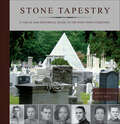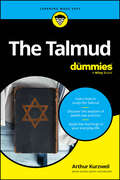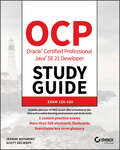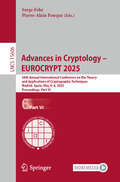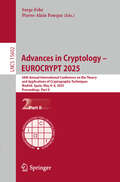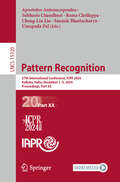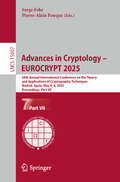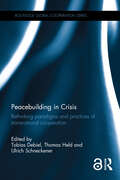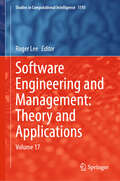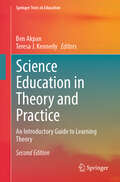- Table View
- List View
Generative AI, Media, and Society
by Katalin FeherThis groundbreaking book demystifies generative AI’s transformative impact on media, socio-cultural dynamics, ethics, and policy.Defining generative AI as an evolutionary leap in the development of artificial intelligence, the author examines intricate human-machine interactions and socio-technical dynamics, advocating robust, proactive AI governance to address emerging uncertainties. The book is clearly structured into six key chapters, each exploring distinct aspects of the relationship between artificial intelligence, media, and society. The chapter on "Transformation" examines how machine behavior is reshaping our datafied society, questioning whether data is the new oil, or digital manure. "Generative AI" investigates the models and future impacts of generative AI as a co-intelligence, revisiting the Turing Test and analyzing societal-business impacts. "AI Media" explores the convergence of media and AI, highlighting robot journalism, synthetic content, and the disinformation era and discussing the trend toward high-risk optimism. "Uncertainties" addresses inherent unpredictability vs. strategic foresight, focusing on challenged business models, sustainability concerns, and emotional intelligence factors. "Ethics" analyzes generative morality and dual-use technology, covering trusted AI principles—from misuse to integrative solutions. Finally, "Policy" discusses governance, labor market impacts, the importance of human rights and power dynamics in generative AI. Each chapter also provides summaries of impact projects, reflective art, scholarly questions, and strategic takeaways—extended with a comprehensive glossary.This is an essential resource for scholars, students, policymakers, technologists, ethicists, and AI industry leaders seeking to rapidly understand and address the challenges and opportunities of generative AI and AI media in a cohesive framework.
Stone Tapestry: A Visual and Historical Guide to the West Point Cemetery
by Robert Holcomb18 Medal of Honor recipients are buried at the West Point Cemetery, along with many of the most influential officers in US Military, including Winfield Scott, George Custer, James Gavin, and William Westmoreland
Statistics Workbook For Dummies with Online Practice
by Deborah J. RumseyPractice your way to a higher statistics score The adage that "practice makes perfect" is never truer than with math problems. Statistics Workbook For Dummies with Online Practice provides succinct content reviews for every topic, with plenty of examples and practice problems for each concept, in the book and online. Every lesson begins with a concept review, followed by a few example problems and plenty of practice problems. There's a step-by-step solution for every problem, with tips and tricks to help with comprehension and retention. New for this edition, free online practice quizzes for each chapter provide extra opportunities to test your knowledge and understanding. Get FREE access to chapter quizzes in an online test bank Work along with each chapter or use the test bank for final exam review Discover which statistical measures are most meaningful Scoring high in your Statistics class has never been easier!
The Talmud For Dummies
by Arthur KurzweilUnlock the wisdom, guidance, and spiritual insight of the Talmud The Talmud For Dummies introduces you to the Jewish guidebook on life and overall cornerstone text of Judaism, the Talmud. This easy-to-understand book makes the Talmud's 63 volumes approachable, so you can deepen your understanding of Jewish teachings. You'll learn about what the Talmud is, get guidance on how to approach Talmud study, and find direction on how to apply the wisdom of the Talmud in your personal and spiritual life. Read the fascinating history of the Talmud and the key figures who shaped it Get advice on how to study the Talmud and uncover its spiritual teachings Apply Talmudic wisdom to everyday life, including marriage, divorce, kosher practices, prayers, and even humor Become well versed in the law of Rabbinic Judaism The Talmud For Dummies is your go-to resource for anyone who wants to study the Talmud, including complete beginners and those looking to brush up their knowledge. Discover the timeless teachings of this profound and influential book with The Talmud For Dummies at your side.
OCP Oracle Certified Professional Java SE 21 Developer Study Guide (Sybex Study Guide)
by Scott Selikoff Jeanne BoyarskyUnlock your Java potential and master the OCP Java SE 21 Developer exam with confidence Dive into the OCP Oracle Certified Professional Java SE 21 Developer Study Guide: Exam 1Z0-830 for a comprehensive journey through the Java SE 21 Developer certification exam. Crafted by a team of seasoned Java professionals, this guide not only prepares you for the 1Z0-830 exam but also equips you with essential skills for both new and existing Java development roles. Enhance your knowledge, refine your skills, and discover new techniques with this expertly written roadmap. Explore the depths of Java development, from writing methods that utilize pattern matching to building applications with virtual threads. This guide covers all you need to ace the certification and excel in your Java development career. Additionally, it provides exclusive access to Sybex's online learning environment and test bank, featuring a wealth of practice questions, electronic flashcards, and a glossary to ensure you're fully prepared for exam day. You'll also: Gain a solid understanding of Java SE 21 features and how to apply them effectively in your development projects Boost your preparation with hundreds of practice questions and valuable online resources from the Sybex online learning environment Quickly reference key concepts thanks to a searchable glossary, making it an indispensable tool for both junior and senior Java developers Whether you're gearing up for the OCP Java SE 21 Developer exam or seeking to solidify your Java expertise, this study guide is an essential resource. It not only serves as a comprehensive preparatory material for the certification but also as a go-to reference for your daily programming needs. Embrace this opportunity to reduce test anxiety, enhance your Java skills, and step confidently into your role as a Java developer. Make this book your coding companion today and set the stage for a thriving career in Java development.
Advances in Cryptology – EUROCRYPT 2025: 44th Annual International Conference on the Theory and Applications of Cryptographic Techniques, Madrid, Spain, May 4–8, 2025, Proceedings, Part VI (Lecture Notes in Computer Science #15606)
by Serge Fehr Pierre-Alain FouqueThis eight-volume set, LNCS 15601-15608, constitutes the proceedings of the 44th Annual International Conference on the Theory and Applications of Cryptographic Techniques, EUROCRYPT 2025, held in Madrid, Spain, during May 4–8, 2025. The 123 papers included in these proceedings were carefully reviewed and selected from 602 submissions. They are organized in topical sections as follows:Part I: Secure Multiparty Computation IPart II: Public-Key Cryptography and Key-ExchangePart III: Advanced Cryptographic SchemesPart IV: (Non-)Interactive Proofs and Zero-KnowledgePart V: Secure Multiparty Computation IIPart VI: MPC II: Private Information Retrieval and Garbling; Algorithms and AttacksPart VII: Theoretical FoundationsPart VIII: Real-World Cryptography
Proceedings of the Second Global Forum on Space Information for Sustainable Development: GFSISD 2024, 25–28 September, Guangzhou, China (Springer Proceedings in Physics #417)
by Ge LuoThis proceedings book gathers the latest research presented at the Second Global Forum on Space Information for Sustainable Development (GFSISD 2024) which hosted by China Association of Remote Sensing Application (CARSA), supported by Guangzhou Association For Science & Technology and took place in Guangzhou, Guangdong Province, China, from September 25th to 28th, 2024”. The forum aimed to investigate the important role of remote sensing in fostering environmental conservation and sustainable development. Both the forum and this proceedings volume address interdisciplinary areas including space information, earth system science, social sciences, economics, and sustainable development. It highlights the enhanced application of spatial information and big data derived from remote sensing in areas such as climate change response, disaster risk reduction, food security, energy and resource management, environmental protection, biodiversity preservation, public health, traffic management, and ocean monitoring. The book provides extensive coverage of three specific goals within the United Nations' 2030 Agenda for Sustainable Development: Goal 2—Zero Hunger, which encompasses sustainable agriculture; Goal 14—Life Below Water, which emphasizes the sustainable use of marine resources; and Goal 15—Life On Land, which focuses on the sustainable use of terrestrial ecosystems. Furthermore, the publication covers the methodologies and applications of remote sensing sensors (both optical and radar) that contribute to sustainability efforts. Contributors to these proceedings include distinguished scholars and industry leaders from across the globe. This collection serves as a valuable resource for researchers, students, professionals, and policymakers involved in space science, information science, earth and environmental sciences, and sustainable development.
Advances in Cryptology – EUROCRYPT 2025: 44th Annual International Conference on the Theory and Applications of Cryptographic Techniques, Madrid, Spain, May 4–8, 2025, Proceedings, Part II (Lecture Notes in Computer Science #15602)
by Serge Fehr Pierre-Alain FouqueThis eight-volume set, LNCS 15601-15608, constitutes the proceedings of the 44th Annual International Conference on the Theory and Applications of Cryptographic Techniques, EUROCRYPT 2025, held in Madrid, Spain, during May 4–8, 2025. The 123 papers included in these proceedings were carefully reviewed and selected from 602 submissions. They are organized in topical sections as follows:Part I: Secure Multiparty Computation IPart II: Public-Key Cryptography and Key-ExchangePart III: Advanced Cryptographic SchemesPart IV: (Non-)Interactive Proofs and Zero-KnowledgePart V: Secure Multiparty Computation IIPart VI: MPC II: Private Information Retrieval and Garbling; Algorithms and AttacksPart VII: Theoretical FoundationsPart VIII: Real-World Cryptography
Pattern Recognition: 27th International Conference, ICPR 2024, Kolkata, India, December 1–5, 2024, Proceedings, Part XX (Lecture Notes in Computer Science #15320)
by Rama Chellappa Subhasis Chaudhuri Cheng-Lin Liu Umapada Pal Apostolos Antonacopoulos Saumik BhattacharyaThe multi-volume set of LNCS books with volume numbers 15301-15333 constitutes the refereed proceedings of the 27th International Conference on Pattern Recognition, ICPR 2024, held in Kolkata, India, during December 1–5, 2024. The 963 papers presented in these proceedings were carefully reviewed and selected from a total of 2106 submissions. They deal with topics such as Pattern Recognition; Artificial Intelligence; Machine Learning; Computer Vision; Robot Vision; Machine Vision; Image Processing; Speech Processing; Signal Processing; Video Processing; Biometrics; Human-Computer Interaction (HCI); Document Analysis; Document Recognition; Biomedical Imaging; Bioinformatics.
Advances in Cryptology – EUROCRYPT 2025: 44th Annual International Conference on the Theory and Applications of Cryptographic Techniques, Madrid, Spain, May 4–8, 2025, Proceedings, Part VII (Lecture Notes in Computer Science #15607)
by Serge Fehr Pierre-Alain FouqueThis eight-volume set, LNCS 15601-15608, constitutes the proceedings of the 44th Annual International Conference on the Theory and Applications of Cryptographic Techniques, EUROCRYPT 2025, held in Madrid, Spain, during May 4–8, 2025. The 123 papers included in these proceedings were carefully reviewed and selected from 602 submissions. They are organized in topical sections as follows:Part I: Secure Multiparty Computation IPart II: Public-Key Cryptography and Key-ExchangePart III: Advanced Cryptographic SchemesPart IV: (Non-)Interactive Proofs and Zero-KnowledgePart V: Secure Multiparty Computation IIPart VI: MPC II: Private Information Retrieval and Garbling; Algorithms and AttacksPart VII: Theoretical FoundationsPart VIII: Real-World Cryptography
Praxishandbuch Facility Management
by Florian Schrammel Christoph Kaiser Jens NusserDieses in zweiter deutlich erweiterter Auflage erschienene Fachbuch ist ein Nachschlagewerk zu sämtlichen Themen der Bewirtschaftung, des Betriebs und der Verwaltung von Gebäuden, die dem Facility Manager bei seiner täglichen Arbeit begegnen. Der besondere Schwerpunkt liegt dabei auf rechtlichen und betriebswirtschaftlichen Fragestellungen sowie auf Nachhaltigkeitsthemen. Der Aufbau des Buches orientiert sich an einem klassischen Ablauf im Facility Management-Prozess. Der Leser findet zu Beginn eines jeden Kapitels eine fundierte und verständliche Einführung in die Thematik, kann aber bei speziellen Fragestellungen auch gezielt nachschlagen. Zahlreiche Beispiele und Praxistipps an den relevanten Stellen runden das Werk ab.
Peacebuilding in Crisis: Rethinking Paradigms and Practices of Transnational Cooperation (Routledge Global Cooperation Series)
by Thomas Held Tobias Debiel Ulrich SchneckenerThe 1990s saw a constant increase in international peace missions, predominantly led by the United Nations, whose mandates were more and more extended to implement societal and political transformations in post-conflict societies. However, in many cases these missions did not meet the high expectations and did not acquire a sufficient legitimacy on the local level. Written by leading experts in the field, this edited volume brings together ‘liberal’ and ‘post-liberal’ approaches to peacebuilding. Besides challenging dominant peacebuilding paradigms, the book scrutinizes how far key concepts of post-liberal peacebuilding offer sound categories and new perspectives to reframe peacebuilding research. It thus moves beyond the ‘liberal’–‘post-liberal’ divide and systematically integrates further perspectives, paving the way for a new era in peacebuilding research which is theory-guided, but also substantiated in the empirical analysis of peacebuilding practices.This book will be essential reading for postgraduate students and scholar-practitioners working in the field of peacebuilding. By embedding the subject area into different research perspectives, the book will also be relevant for scholars who come from related backgrounds, such as democracy promotion, transitional justice, statebuilding, conflict and development research and international relations in general.
Ransomware Analysis: Knowledge Extraction and Classification for Advanced Cyber Threat Intelligence
by Jérôme François Claudia Lanza Abdelkader LahmadiThis book presents the development of a classification scheme to organize and represent ransomware threat knowledge through the implementation of an innovative methodology centered around the semantic annotation of domain-specific source documentation. By combining principles from computer science, document management, and semantic data processing, the research establishes an innovative framework to organize ransomware data extracted from specialized source texts in a systematic classification system.Through detailed chapters, the book explores the process of applying semantic annotation to a specialized corpus comprising CVE prose descriptions linked to known ransomware threats. This approach not only organizes but also deeply analyzes these descriptions, uncovering patterns and vulnerabilities within ransomware operations. The book presents a pioneering methodology that integrates CVE descriptions with ATT&CK frameworks, significantly refining the granularity of threat intelligence.The insights gained from a pattern-based analysis of vulnerability-related documentation are structured into a hierarchical model within an ontology framework, enhancing the capability for predictive operations. This model prepares cybersecurity professionals to anticipate and mitigate risks associated with new vulnerabilities as they are cataloged in the CVE list, by identifying recurrent characteristics tied to specific ransomware and related vulnerabilities.With real-world examples, this book empowers its readers to implement these methodologies in their environments, leading to improved prediction and prevention strategies in the face of growing ransomware challenges.
Game Theory for Applied Econometricians: Data Analytics with R (Chapman and Hall/CRC Series on Statistics in Business and Economics)
by Christopher P. AdamsOver the last 30 years the practice and use of game theory has changed dramatically, yet textbooks continue to present game theory with algebraic formalism and toy models. This book, on the other hand, illustrates game theory concepts using real-world data and analyses problems with real policy implications. The focus is on applying current learning to real world problems by providing an introduction to game theory and econometric analysis based on game theoretic principles using the computer language R.The book covers the standard topics of an introductory game theory course including dominant strategies, Nash equilibrium and Bayes Nash equilibrium. It layers on top of this an approach to statistics and econometrics called Structural Modeling. In this approach, key parameter estimates rely upon game theoretic analysis. The real-world examples used to illustrate these concepts vary in scope and include an analysis of bargaining between hospitals and insurers, equilibrium entry of retail tire stores, bid rigging in timber auctions and contracts in 19th century whaling.This book is aimed at the general reader with the equivalent of a bachelor’s degree in economics, statistics or some more technical field. The book could be used as a text for an upper level undergraduate course or a lower level graduate course in economics or business.
Dante and Epicurus: A Dualistic Vision of Secular and Spiritual Fulfilment
by George Corbett"Dante and Epicurus seem poles apart. Dante, a committed Christian, depicted in the Commedia a vision of the afterlife and God's divine justice. Epicurus, a pagan philosopher, taught that the soul is mortal and that all religion is vain superstition. And yet Epicurus is, for Dante, not only the quintessential heretic but an ethical ally. The key to this apparent paradox lies in the heterodox dualism - between man's two goals of secular felicity and spiritual beatitude - at the heart of Dante's ethical, political and theological thought. Corbett's full-length treatment of Dante's reception and polemical representation of Epicurus addresses a major gap in the scholarship. Furthermore the study's focus on fault lines in Dante's vision of the afterlife- where the theological tensions implicit in his dualism surface - opens a new way to read the Commedia as a whole in dualistic terms."
Software Engineering and Management: Volume 17 (Studies in Computational Intelligence #1193)
by Roger LeeThis book reports state-of-the-art results in Software Engineering Research, Management & Applications in both printed and electronic form. Studies in Computation Intelligence (SCI) has grown into the most comprehensive computational intelligence research forum available in the world. This book published original papers on both theory and practice that address foundations, state-of-the-art problems and solutions, and crucial challenges.
Trends in Clean Energy Research: Selected Papers from the 9th International Conference on Advances on Clean Energy Research (ICACER 2024) (Green Energy and Technology)
by Lin ChenThis book offers a comprehensive exploration of the latest novel and fundamental advances in clean energy resources and systems, energy economics, and energy policy. Designed to help steer the course toward a cleaner, more sustainable energy landscape, it presents case studies on clean energy technology, explores sustainable methods for increasing energy efficiency, and examines current concepts and solutions to global energy storage and energy-saving issues. Topics covered include:Clean coal and fossil fuels;Green power production and cogeneration;CO2 capture, storage, and utilization;Biomass, wind, and nuclear energy engineering;Hydrogen and fuel cell technology.Trends in Clean Energy Research is an essential guide to current research for scientists, practitioners, engineers, students, and researchers.
Designing ICT around Food Practices in the Digital Age: Informing and Filtering the Design Space of Food Practices to Support Diverse Instances of Eating Practices
by Philip WeberHuman-Food Interaction (HFI), a subfield of Human-Computer Interaction (HCI), examines how technology shapes food practices, from shopping and cooking to eating and disposal. This book focuses on eating, particularly dining out, and explores the role of technology in these practices.Methodologically, it maps the design space by studying eating habits before, during, and after meals, the impact of COVID-19, and food influencers&’ digital work. Observational studies, interviews, and social media analyses provide a rich foundation for understanding these dynamics.Additionally, the book refines the design space through prototyping and evaluating three ICT artifacts, using participatory design and user studies. Findings offer insights into tailoring technology for diverse eating contexts, contributing to more context-aware and supportive food-related technologies.
Husserls Erweiterung des Willensbegriffs und ihre Bedeutung für die Handlungstheorie
by Zixuan LiuHusserls Erweiterung des Willensbegriffs ist eine durchaus beobachtete, aber nicht hinreichend ernst genommene Transformation. Zixuan Liu untersucht in diesem Buch, wie und warum Husserl seinen Willensbegriff erweiterte und was für eine Bedeutung dieser erweiterte Willensbegriff für Husserls eigenes System und die Handlungstheorie haben kann. Zunächst wird Husserls Erweiterung des Willensbegriffs in sechs Richtungen differenziert. Der Erste Weltkrieg stellt sich als der historische Hintergrund dieser Transformation dar. Die Erweiterung liegt unter anderem an Husserls eigener Gedankenentwicklung und dem Einfluss durch andere Autoren. Der Autor untersucht die Herausforderungen des erweiterten Willensbegriffs für Husserls eigenes System. Es ergibt sich die Intentionalität als eine einzigartige Beziehung, die sich nur für Sinngewinnung verantworten muss. Als eine Alternative zu Husserls klassischem intellektualistischem Stufenbau von Erkennen, Fühlen und Wollen argumentiert der Autor für eine aspektuale Ansicht zu dieser Trichotomie. Schließlich versucht Zixuan Liu, mit Husserls Ressourcen kritisch in die handlungstheoretischen Debatten einzugreifen und umgekehrt Husserls Phänomenologie mit der Handlungstheorie zu bereichern.
Image-Based Prediction of Retinal Disease Progression: MICCAI Challenges, DIAMOND 2024 and MARIO 2024, Held in Conjunction with MICCAI 2024, Marrakesh, Morocco, October 10, 2024, Proceedings (Lecture Notes in Computer Science #15503)
by Gwenolé Quellec Mostafa El Habib Daho Rachid ZeghlacheThis book constitutes the proceedings from the MICCAI Challenges, Device-Independent Diabetic Macular Edema Onset Prediction, DIAMOND 2024, and Monitoring Age-Related macular degeneration progression in Optical coherence tomography, MARIO 2024, held in conjunction with the 27th International conference on Medical Image Computing and Computer Assisted Intervention, MICCAI 2024, in Marrakesh, Morocco in October 2024. The 15 papers included in this book from MARIO 2024 were carefully reviewed and selected from 17 submissions, whereas the 6 papers included here from DIAMOND 2024 were carefully reviewed and selected from 8 submissions. These papers focus on a wide range of state-of-the-art deep learning approaches to derive patient specific rules for Diabetic retinopathy (DR) and age-related macular degeneration (AMD) progression prediction from retinal images.
Science Education in Theory and Practice: An Introductory Guide to Learning Theory (Springer Texts in Education)
by Ben Akpan Teresa J. KennedyThis book addresses the critical role of science education in the context of global growth and development, emphasizing its significance in the advancement of societal progress. The book identifies and explores the lack of comprehensive resources compiling diverse learning theories and their practical applications in science teaching. Tailored for a global audience, it bridges the knowledge gap with a narrative genre, offering a cohesive exploration of fundamental theories and applications. With contributors from 14 countries, this edition goes beyond its predecessor, delivering updated insights across chapters in research, pedagogy, and educational theory. Each chapter enriches the reader's experience with exercises and reflections, fostering deeper engagement. Notably, the second edition responds to the evolving educational landscape, introducing Chapter 28 on Virtual Technology in the wake of the COVID-19 pandemic. This book is an invaluable resource for students, educators and researchers interested in science education, providing a comprehensive exploration of updated theories and practices.
Plant Nanotechnology Fundamentals and Methodologies (Nanotechnology in Plant Sciences #1)
by Shri Mohan Jain Jameel M. Al-Khayri T. R. AnjuThe book provides an accessible introduction to the core concepts of nanotechnology, the interactions between plants and nanoparticles, and the basic techniques for delivering nanoparticles to plant systems. It offers detailed methodologies and in-depth discussions on the intersection of nanotechnology and plants. The chapters are organized to convey fundamental ideas and provide a comprehensive understanding of plant nanotechnology for readers of all levels. Currently, there is a lack of books addressing interdisciplinary research with a precise overview, and this book can fulfill that demand. The book will serve as a valuable source of fundamental and up-to-date information in the field of plant nanotechnology for graduate students, research scholars, academicians, and scientists from various disciplines.
Innovations in Neurocognitive Rehabilitation: Harnessing Technology for Effective Therapy
by K. Jayasankara ReddyNeurocognitive disorders, such as Alzheimer's disease, stroke, and traumatic brain injuries, have a significant global impact, causing significant challenges for healthcare systems and families. Traditional rehabilitation methods often do not effectively target the diverse and complex cognitive impairments associated with these illnesses. Technology facilitates personalized rehabilitation approaches, enhances patient engagement, and enables unbiased evaluations of progress. This book is particularly pertinent in an era of rapid technological advancement, as it presents exceptional opportunities to revolutionize neurorehabilitation techniques and improve patient outcomes.
Conference Proceedings of the 2024 4th International Joint Conference on Energy, Electrical and Power Engineering: Volume I (Lecture Notes in Electrical Engineering #1408)
by Weimin Wu Xinzhang Wu Kun TanEnergy, Electrical, and Power Engineering are dynamic fields undergoing rapid change and innovation. This volume encompasses cutting-edge research and advances in electrical and power engineering, covering a wide range of topics including power electronics technology, renewable energy generation, intelligent control systems, and more. With contributions from renowned experts and scholars, it provides valuable insights and innovative solutions to address the challenges and opportunities in the ever-evolving energy landscape. This volume serves as a comprehensive resource for staying abreast of the latest trends and act as a catalyst for advancing this dynamic field. Following the success of the CoEEPE 2021, 2022 and 2023, this volume will provide resources for a diverse readership, including professionals, scientists, practitioners, researchers, and graduate students.
Antibiotic Residue and Resistance in Seafood Safety and Quality
by Asem Sanjit Singh Manoharmayum Shaya Devi Upendra NongthombaThis book embark explores the global antibiotic trends in seafood, and delves into the intricate interplay between antibiotic consumption and its ramifications within the seafood industry. The nuanced effects of processing techniques on antibiotic residue levels in seafood are investigated, elucidating the prevalence of antibiotics and their metabolites within these commodities. The book also peers into the microbial realm of seafood, revealing the intricacies of resistance mechanisms, prevalence rates, pathogenicity, and related phenomena. It then explores the antibiotic alternatives in aquatic environments, including the utilization of nanoparticles and plant extracts. Artificial intelligence integration and sensor development for antibiotic residue detection ensures quality assurance and consumer safety within the seafood industry, and has been well-covered in this volume. This edited volume is beneficial for graduate students in fisheries science, life sciences, animal biotechnology, zoology, and microbiology. This can be a reference material for fisheries professionals, scientific communities, researchers, and scholars as well, for navigating the global antibiotic trends in seafood.

